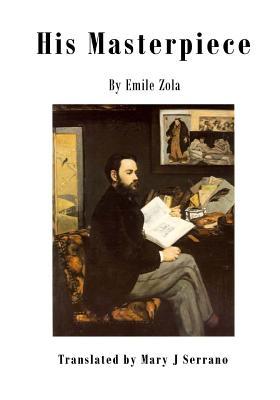His Masterpiece
By Emile Zola
Translated by Mary J Serrano
L'oeuvre is the fourteenth novel in the Rougon-Macquart series by Emile Zola. It was first serialized in the periodical Gil Blas beginning in December 1885 before being published in novel form by Charpentier in 1886.
The title, translated literally as "The Work" (as in work of art), is often rendered in English as The Masterpiece or His Masterpiece. It refers to the struggles of the protagonist Claude Lantier to paint a great work reflecting his talent and genius.
Painter Claude Lantier advocates painting real subjects in real places, most notably outdoors. This is in stark contrast to the artistic establishment, where artists painted in the studio and concentrated on mythological, historical and religious subjects. His art making is revolutionary and he has a small circle of like-minded friends equally intent on shaking up the art world and challenging the establishment. His best friends are his childhood comrades Pierre Sandoz, novelist and Louis Dubuche, an architect. Like Zola, Sandoz contemplates a series of novels about a family based in science and incorporating modern people and everyday lives. Dubuche is not half as bold as Claude and, although a painter, finds music to be his passion. He chooses a more conventional course, opting for the security of a middle-class life and a bourgeois marriage. Sandoz also pursues marriage - not for love but stability and to better understand what he is writing about. The outcry in the artistic community over the sidelining of new artists in favor of popular, established, traditional artists at the annual Salon of the Academie des Beaux-Arts leads to the creation of a Salon des Refuses for the rejected artists to display their work. No painting gathers more interest or generates more criticism than Claude's. Entitled Plein Air (Open Air), it depicts a nude female figure in the front center and two female nudes in the background, with a fully dressed man, back to the viewer in the foreground. (Zola deliberately invokes Le dejeuner sur l'herbe by Edouard Manet, which provoked outcries at the actual Salon des Refuses in 1863.)
Claude moves to the country to soak up more of the 'Open Air' atmosphere he revelled in as a child and to create more masterpieces. Accompanying him is Christine Hallegrain, who served as the model for Claude's nude and they have a son. Claude is unable to paint much and grows more and more depressed. For the sake of his health, Christine convinces him to return to Paris. Claude has three paintings in three years rejected by the Salon before a spectacular view of the Ile de la Cite captures his imagination. He becomes obsessed with this vision and constructs a massive canvas on which to paint his masterpiece. He is unable to project his ideas successfully or combine them into a meaningful whole. He begins adding incongruous elements (like a female nude bather), reworks and repaints until the whole enterprise collapses into disaster, then starts over. His inability to create his masterpiece deepens his depression. The slow breakup of his circle of friends contributes to his decaying mental state, as does the success of one of his confreres, a lesser talent who has co-opted the 'Open Air' school and made it a critical and financial triumph.
